JEE Main Important Physics formulas
ApplyAs per latest 2024 syllabus. Physics formulas, equations, & laws of class 11 & 12th chapters
An acceleration-time graph depicts the relationship between acceleration and time, with acceleration represented on the Y-axis and time plotted on the X-axis. It is created by plotting the data of acceleration and time collected while analyzing the motion of a body on a rectangle graph. An acceleration-time graph can be used to calculate the change in velocity over a particular time interval. We may calculate the change in velocity of an object in motion during a certain period by calculating the area under the curve of the acceleration-time graph.
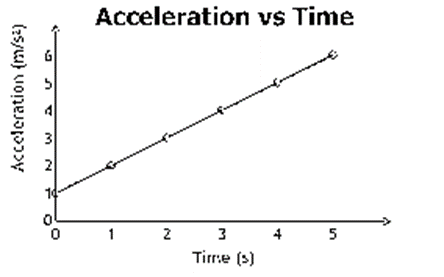
Rate of change of velocity with respect to time in a given interval of time in terms of both speed and direction is known as acceleration.
It is a vector quantity and depends on the direction of the motion of the object.
Its SI unit is m/s2 and its CGS unit is cm/s2.
A straight-line moving point or object is accelerated if it speeds up or slows down. Motion in a circle is accelerated even if the speed is constant because the direction is always changing. For all other types of motion, both effects contribute to acceleration.
Acceleration =\frac{Change\ in\ velocity}{Time\ Taken}
![]()
Uniform acceleration: - An object in uniformly accelerated motion traverses identical distances in equal time intervals, regardless of time duration.
Non-Uniform acceleration: - A non-uniform accelerated motion item does not traverse the same distance in equal time intervals, regardless of time interval duration.
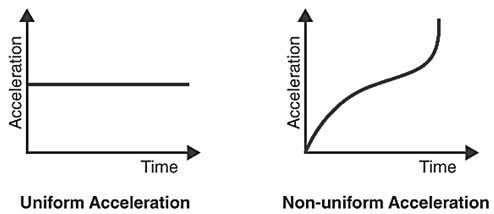
The average acceleration is the change in velocity over a certain time span. It is equal to the entire change in velocity throughout the given timeframe divided by the total time required to make the change. The average acceleration may be computed as follows:
Average\ Acceleration (\vec{a}_{avg})=(\frac{Final\ Velocity-Initial\ velocity}{Time})=(\frac{Change\ in\ Velocity}{Change\ in\ Time})
![]()
(\vec{a}_{avg})=(\frac{\bigtriangleup v }{\bigtriangleup t})=(\frac{v_{f}-v_{i}}{t_{f}-t_{u}})![]()
Where,
vf= Final velocity of the object
vi= Initial velocity of the object
tf= Final time
ti= Initial time
The ratio of change in velocity within a certain time period such that the time interval equals zero is known as instantaneous acceleration.
Time is represented along the x-axis, while velocity is plotted along the y-axis in the velocity-time graph. Here are some examples of velocity-time graphs for acceleration:
When the object's acceleration is zero or its velocity is constant.
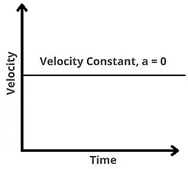
When the rate of acceleration increases and drops.
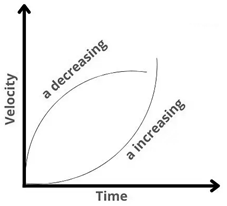
When an item moves with uniform acceleration and has a zero starting velocity.

When the particle moves with constant deceleration (negative acceleration).
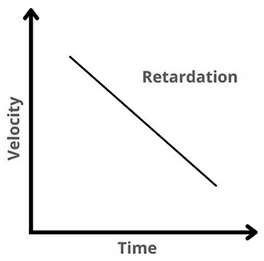
When an object moves with non-uniform acceleration and its initial velocity is zero.
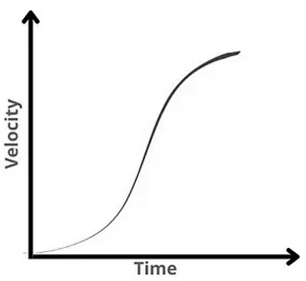
The area under the acceleration graph reflects the change in velocity. In other words, the area under the graph for a given time interval equals the change in velocity during that time interval.
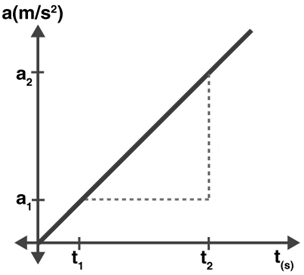
Acceleration is defined as the rate of change of velocity with respect to time.
The change in velocity in acceleration might be an increase or reduction in speed or a change in direction of motion.
Acceleration is a vector quantity, with the SI unit being m/s2.
Acceleration is defined as the change in velocity divided by the time taken, written as a = (v - u) / t.
If the velocity raises, decreases, or is 0 with respect to time, the acceleration is said to be positive, negative, or zero.
There are two forms of acceleration: uniform and non-uniform motion, average acceleration, and instantaneous acceleration.
The acceleration-time graph plots the acceleration versus time for a particle travelling in a straight line.
In the same way as velocity versus time graphs inform us about an object's displacement, acceleration-time graphs tell us about its velocity.
The change in velocity for a given time interval is shown by the area under any acceleration graph for that time interval.
The jerk is represented by the slope of the acceleration time graph.
Acceleration measurements are plotted on the y-axis, while time values are plotted on the x-axis in the acceleration versus time graph.
Apr 27, 2022 - 12:42 p.m. IST ---STATIC
Apr 27, 2022 - 12:42 p.m. IST ---STATIC
Apr 27, 2022 - 12:42 p.m. IST ---STATIC
Apr 27, 2022 - 12:42 p.m. IST ---STATIC
Apr 27, 2022 - 12:42 p.m. IST ---STATIC
Apr 27, 2022 - 12:42 p.m. IST ---STATIC
Apr 27, 2022 - 12:42 p.m. IST ---STATIC
Apr 27, 2022 - 12:42 p.m. IST ---STATIC
Apr 27, 2022 - 12:42 p.m. IST ---STATIC
Apr 27, 2022 - 12:42 p.m. IST ---STATIC

As per latest 2024 syllabus. Physics formulas, equations, & laws of class 11 & 12th chapters

Get up to 90% scholarship on NEET, JEE & Foundation courses

As per latest 2024 syllabus. Chemistry formulas, equations, & laws of class 11 & 12th chapters

Enrol in PACE IIT & Medical, Financial District, Hyd for JEE/NEET preparation

Start your JEE preparation with ALLEN

Ace your NEET preparation with ALLEN Online Programs